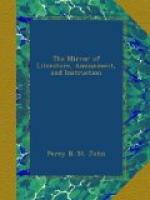By a statute made in the 5th year of Edward IV., every Englishman, and Irishman dwelling with Englishmen, was directed to have a bow of his own height made of yew, wych-hazel, ash, or awburne—that is, laburnum, which is still styled “awburne saugh,” or awburne willow, in many parts of Scotland. His skill in the use of the long bow was the proud distinction of the English yeoman, and it was his boast that none but an Englishman could bend that powerful weapon. It seems that there was a peculiar art in the English use of this bow; for our archers did not employ all their muscular strength in drawing the string with the right hand, but thrust the whole weight of the body into the horns of the bow with the left. Chaucer describes his archer as carrying “a mighty bowe;” and the “cloth-yard shaft,” which was discharged from this engine, is often mentioned by our old poets and chroniclers. The command of Richard III. at the battle which was fatal to him, was this:
“Draw, archers, draw your arrows to the head.”
The bowmen were the chief reliance of the English leaders in those bloody battles which attended our unjust contests for the succession to the crown of France. Some of these scenes are graphically described by Froissart.
Box
Is a native of all the middle and southern parts of Europe; and it is found in greater abundance and of a larger size in the countries on the west of Asia, to the south of the mountains of Caucasus. In many parts of France it is also plentiful, though generally in the character of a shrub. In early times it flourished upon many of the barren hills of England. Evelyn found it upon some of the higher hills in Surrey, displaying its myrtle-shaped leaves and its bright green in the depth of winter; and, till very recently, it gave to Boxhill, in that county, the charms of a delightful and perennial verdure. The trees have now been destroyed, and the name, as at other places called after the box, has become the monument of its former beauty.[4]
[4] In the twelfth volume
of the MIRROR, we gave an accurate picture
of
the past and present celebrity of Box Hill,
especially with
respect
to the quantity of box grown there. The box trees
on the
hill
are again flourishing, and with these and other evergreens
the
chief part of Box Hill is still covered.
Yet no tree so well merits cultivation—though its growth be slow. It is an unique among timber, and combines qualities which are not found existing together in any other. It is as close and as heavy as ebony; not very much softer than lignumvitae; it cuts better than any other wood; and when an edge is made of the ends of the fibres, it stands better than lead or tin, nay almost as well as brass. Like holly, the box is very retentive of its sap, and warps when not properly dried, though when sufficiently seasoned it stands well. Hence, for the wooden




